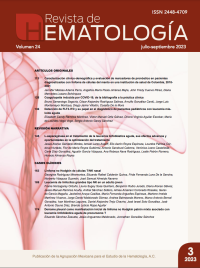Detection of FLT3-ITD and its role in the diagnosis of pediatric patients with acute myeloid leukemia.
Rev Hematol Mex. 2023; 24 (3): 136-144. https://doi.org/10.24245/rev_hematol.v24i3.6896
Elizabeth Candy Ramírez Martínez,1 Víctor Manuel Ortiz Gálvez,1 Dinora Virginia Aguilar Escobar,2 María de Lourdes Vega Vega,3 Sergio Antonio Garay Sánchez1
1 Departamento de Genética Molecular.
2 Subdirección de Diagnóstico y Banco de Sangre.
3 Dirección General.
Hospital Infantil Teletón de Oncología, Santiago de Querétaro, México.
Resumen
OBJETIVO: Implementar en el laboratorio la detección de FLT3-ITD en pacientes pediátricos con leucemia mieloide aguda.
MATERIALES Y MÉTODOS: Estudio retrospectivo efectuado de 2016 a 2020, en el que detallamos la técnica de PCR seguida de electroforesis capilar, mostrando la estrategia de validación del ensayo y nuestra experiencia en el uso de esta técnica en 14 muestras de médula ósea de pacientes pediátricos.
RESULTADOS: La técnica de PCR seguida de electroforesis capilar es un método confiable, robusto y preciso, que alcanza sensibilidad de un radio alélico (AR) de 0.01 ± 0.001. Observamos incidencia de la mutación FLT3-ITD del 14.3% que además presentaron la t(15;17)(q22;q12).
CONCLUSIONES: Esta técnica puede ser reproducible en otros centros de diagnóstico molecular ayudando al médico en la estratificación del riesgo, seguimiento, tratamiento y pronóstico del paciente con leucemia mieloide aguda.
PALABRAS CLAVE: Leucemia mieloblástica aguda; pronóstico; recaída; pediatría; Latinoamérica.
Abstract
OBJECTIVE: To implement the detection of FLT3-ITD in pediatric patients with acute myeloid leukemia.
MATERIALS AND METHODS: A retrospective study performed from 2016 to 2020 in which we detail the PCR technique followed by capillary electrophoresis; showing the validation strategy of the trial and our experience in the use of this technique in 14 bone marrow samples of pediatric patients.
RESULTS: We showed that it is an accuracy, robust and precise method, detecting a sensitivity of the test of an allelic radius (AR) of 0.01 ± 0.001. We observed an incidence of the mutation FLT3-ITD of 14.3% with acute myeloid leukemia that also had t(15;17)(q22; q12).
CONCLUSIONS: This technique can be reproduced in other molecular diagnostic centers, helping the doctor in the risk stratification, monitoring, treatment and prognosis of the patient with acute myeloid leukemia.
KEYWORDS: Acute myeloid leukemia; Prognosis; Relapse; Pediatrics; Latin America.
Recibido: septiembre 2021
Aceptado: agosto 2023
Este artículo debe citarse como: Ramírez-Martínez EC, Ortiz-Gálvez VM, Aguilar-Escobar DV, Vega-Vega ML, Garay-Sánchez SA. Detección de FLT3-ITD y su papel en el diagnóstico de pacientes pediátricos con leucemia mieloide aguda. Hematol Méx 2023; 24 (3): 136-144.

